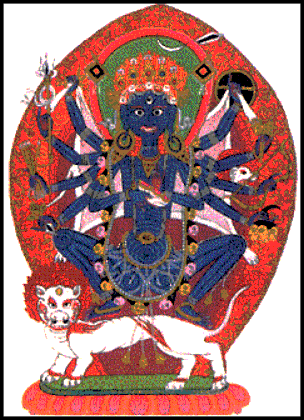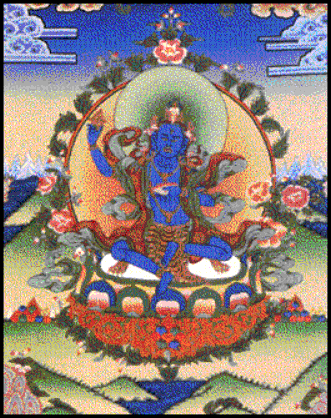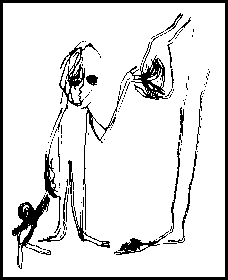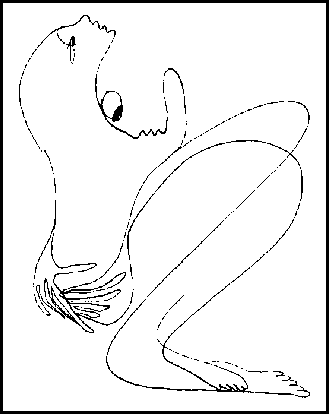Poems
Joseph Brodsky
(Farrar Straus)
I arrive at Christmas without a kopeck.
The publisher's dragging on with my epic.
The Moscow calendar's going Islamic.
I'm not going anywhere...
Brodsky, on one hand, can be a merry writer, able to do comic reversals out of the best of Lord Byron, where the poem (and the reader) are off on one track (in this case money turning into flowers) and suddenly the author intrudes, crying for air:
Freshly minted wads of cash are
rustling like the tops of acacias,
I'm foundering in hallucinations ----
somebody give me oxygen!
Like Byron, too, he can turn a Christmas cliché on its head, immediately pull in an obscure reference to Hobbes, and then give a sweetly ironic twist on an indelicate medical procedure:
Comfort, then, and for us all.
(This you find in Hobbes, et al.)
I count a hundred, sitting still.
A purge is not a nice procedure.
He can start off with an image worthy of Wordsworth and suddenly turn the sword, tossing in a line-break to emphasize a pure ethical dilemma:
Each soul, lapped in a flowing veil,
will link in a continual spiral,
live by ethyl-
float away from Word...
But, most of all, it's the elements of Philip Larkin that delight: Larkin, with his blear images, seedy rooms, dead-end people, trash and detritus, the bleakness of the day-to-day:
...from this general nirvana
laws will flutter down in visions,
addicts will be fixing ribbons
on themselves. Instead of icons,
old syringes in a corner...
Or this very Larkinesque snapshot of the TV-infested lobby of a Moscow pension: Down in the lobby three elderly women, bored,
pension Academia, side by side,
take up, with their knitting, the Passion of Our Lord
as the universe and the tiny realm
of the
with TV blaring, sail into Christmastide,
a lookout desk clerk at the helm.
Here we get the three wise men in eerie echo, the whole of divine coming encompassed by three bored ladies tending to their knitting, in a hotel lobby which (with the noisy television going) turns into a vessel sailing into the "Christmastide", the desk clerk at the ship's lookout.
Or take this potent commentary on the Soviet state, his day-to-day world:
Equality, pal, throws brotherhood off.
Better make sense of that. A slave
breeds nothing but another slave,
and no less after a revolution.
But Brodsky, in the end, defies comparisons. He rises above his inspirations to come out as a pure original. Those of us who still care for poetry hold him in the highest regard because of his ability to mix divinity and discouragement, hope and despair, the sarcastic aside blended with a heart-felt Christian passion.
Only Brodsky could fabricate a verse in which he turns himself into the neo-Christ ("on an ass"), and at the same time, mocks his own arrogance as he touches on woes and wife and child and death, bringing in the divine to end in a tough echo of that very sappy "Dover Beach:"
And I, a writer who has seen the world,
who has crossed the equator on an ass
look out the window at the hills asleep
and think about the identity of our woes:
the Emperor won't see him, I won't be
seen by my son and Cynthia ... And we,
we here shall perish. Arrogance will not raise
our bitter fate to the level of proof
that we are made in the Creator's image
The grave will render all alike.
So, if only in our lifetime, let us be various!...
In all, there are seventeen poems presented here alongside the Russian originals. Translators include Seamus Heaney, Derek Walcott, and Richard Wilbur --- but the ones we found most affecting were Glyn Maxwell, Daniel Weissbort, George L Kline, Anthony Hecht and Alan Myers with the author.
Tantra in the
Himalayas
Claudia Múller-Ebeling, et al
(Inner Traditions)

Claudia Müller-Ebeling, Christian Rätsch, and Surendra Bahadur Shahi have written the comprehensive work on shamanistic practices in Nepal. The book itself is a work of art with over four hundred photographs and drawings depicting such obscure (and lovely) holy figures as Tika Bhairab. Bhairab is a snarly dancing fellow, his hair filled with tiny skulls, malign clouds floating around and about. He brings you good luck but, being of shamanistic practice, is an emanation of Shiva and she will eat you alive if you don't mind your p's and q's. Or you can find a glorious representation of Garuda, complete with wings, three eyes, vicious beak --- the god standing atop a snake, floating above the clouds. The snake, the authors explain, is naga, a divine being who represents strength and wisdom, but (Shiva again) can also bring sudden illness. Garuda, they point out, may go back to the Sumerians, emerging from the Bon figures --- Khading and Khyung --- the twins who emerged from of the cosmic egg, springing forth as light and dark. In tantra, they tell us, the bird Garuda represents the energy of fire, which heals diseases --- such as cancer --- that are caused by the nagas or the water spirits. This is no dry scholarly tome. The authors have gone into the mountains and valleys of Nepal and participated in the elaborate ceremonies of the shamans which they call "a combination of natural science, psychotherapy, and theatrical comedy." They have come to learn at the hands of the masters and they reveal that they are often deeply touched by their experiences. This is Christian Rätsch going into upper Nepal through streams, along rock paths, in the midst of torrential rains, finding, near the peak Kidorje, a house "of many rooms" ... "Humans and animals under the same roof." There he finds the shaman Myingmar Sherpa sitting in trance. 
I sit down cross-
Roar
Stories, Poems,
And Drawings
Ava Kadishson Schieber
(Northwestern University)

Soundless Roar is a collection of essays, poems, and drawings having to do with being in hiding --- from the world, from her feelings --- for four years.
She lost her grandparents, her father and her sister to the Holocaust, and her mother never recovered. In a sense, Ms. Schieber never recovered either. At the end of the fighting, she moved back to Belgrade, in a room filled with other refugees, but
I was sitting in the midst of people who I believed felt friendly toward me yet for many hours, no one asked me anything. They were talking; I was not listening. Like a mummy, entirely dried up, devoid of any internal organs, I felt myself to be an empty shell.
Her writing, too, is careful, drained of charged words, direct and simple --- which does not vitiate its power. The events she is reporting, the changes within, are so powerful that to dramatize the story is unnecessary.
Many of the memories are sad, some startling. Towards the end, she was walking through the city, looking for her family. She found the building where they had lived but it was empty. All she had with her was her dog, which she held "tightly across my chest:"
I had heard the whistling bullets on my long trek into the city and had decided to walk only in the middle of the main wide streets. That way I was highly visible, especially in the isolated pockets of fighting in the city. Some buildings harbored lonely snipers. No one could mistakenly believe I was part of any fighting groups. I was a short skinny girl, dressed in rags, carrying a dog in my arms. It felt good to have his head on my shoulder. If someone took aim at me, it would be less lonely to die this way.
 At the end of the war, she set off into Hungary to see if she could find any news of her father and sister. She brought only her documents with her. When she found the partisan general command, she asked about her family, and presented her papers.
At the end of the war, she set off into Hungary to see if she could find any news of her father and sister. She brought only her documents with her. When she found the partisan general command, she asked about her family, and presented her papers.
I have never forgotten the officer who looked first at my papers, then at me, and said, "Interesting --- the Jews are already returning."
Instantly, with rising hope, I asked: "Who is back?"
The man's face flushed and he slowly responded, "You are the first."
I knew then the liberation was not meant for me.